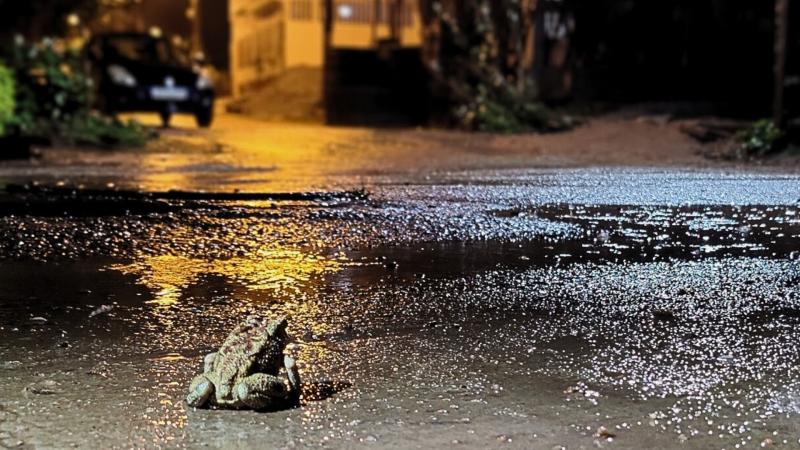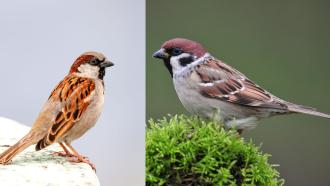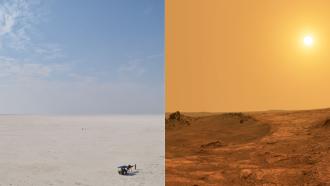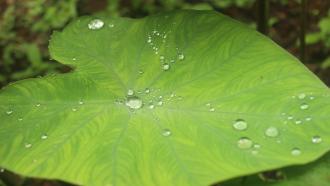
Bengaluru, despite being known for its traffic snarls and bustling IT companies, is home to a surprisingly resilient community of frogs and toads, collectively known as anurans. Contrary to the expected sharp decline in biodiversity that often accompanies urban sprawl, a new systematic survey of the city's green spaces and wetlands reveals that anuran species composition remains broadly similar across areas ranging from the rural periphery to the inner city.
Researchers from Ashoka Trust for Research in Ecology and the Environment (ATREE), Dakshin Foundation, Bengaluru, Centre for Ecological Sciences, Indian Institute of Science (IISc), Gubbi Labs, Karnataka, and the Indian Institute of Science Education and Research (IISER) Bhopal, conducted a survey of 32 locations across Bengaluru to look for its frogs and toads. They found a total of 11 anuran species across various habitats, suggesting they may be more adaptable to city life than previously thought, or that the worst impacts are yet to come, a phenomenon the researchers call a lag phase.
Did You Know? The city of Bengaluru, despite its rapid growth, still retains a network of natural landscapes, including engineered wetlands (locally called Kere), that sustain biodiversity. |
This study addresses a critical knowledge gap concerning less charismatic fauna in the rapidly urbanising Global South. Amphibians are among the most vulnerable vertebrates globally, facing threats from reduced habitat availability and quality, especially in tropical regions with high species diversity. For a megadiverse country like India, which is rapidly urbanising and expected to have an estimated 600 million people living in cities by 2031, understanding the fate of amphibians offers a glimpse into the city’s ecological health.
To understand how frogs and toads were faring, the researchers surveyed 32 locations using a 4x4 km grid. The grids divided the city into four categories based on the percentage of built-up area, the total area covered by buildings and other permanent structures and infrastructure like roads, ranging from 0–20% up to 60–80%. Sampling was restricted to the city's primary remnant green spaces: wetlands, public parks, and institutional campuses.
The surveys, conducted between February and September 2022 during both the pre-monsoon and monsoon seasons, followed an Audio-Visual Encounter Survey protocol, which involved two researchers traversing pathways and water edges between 6 PM and 10 PM to locate and identify anurans either visually or by using their sound. The team recorded 322 individuals belonging to 11 species across the city. The dominant species encountered during the surveys were those known to be highly adaptable, such as the Common Indian Toad (Duttaphrynus melanostictus) and the cricket frog (Minervarya agricola), which thrive in human-altered and polluted habitats.
Their analysis revealed that, at the broadest landscape scale, sites farther from the city centre and with lower pollution levels led to higher diversity in the anuran composition. Conversely, at the microhabitat level, two drivers emerged as particularly important. The presence of submerged native aquatic plants, such as Potamogeton and Hydrilla genera, and Typha sp. reedbeds was positively associated with anuran diversity, as these serve as vital breeding habitats. In a worrying trend, however, anuran composition decreased in wetlands with sewage. Surprisingly, the presence of stone pitching, the process of laying stones to create a stable surface, typically on slopes, riverbanks, or embankments, a feature of many restored wetlands, also negatively affected anuran composition.
While these environmental factors showed clear trends in their association with anuran presence, the overall statistical association between these variables and species composition was not statistically significant at either the landscape or microhabitat scale. This non-significant finding leads the researchers to two main possibilities: either anurans are currently more resilient to urbanisation than previously presumed, or there is a lag phase at work, meaning the long-term, irreversible impacts of habitat conversion and pollution have not yet fully manifested in species composition. Despite the general similarity across the city, the rate of species accumulation was shallower for the most built-up areas, suggesting a restricted species pool within the inner city.
The study acknowledges that sampling was confined to the aquatic-terrestrial interface in the few remaining green spaces and omitted other potential microhabitats like vacant plots or agricultural fields. Furthermore, the assessment of habitat quality relied on qualitative indicators, like the visual presence of sewage or stone pitching, rather than quantitative data like detailed water chemistry, which might have yielded stronger statistical results.
The findings strongly advocate for a fundamental change in how city planning and wetland restoration are approached. The work also establishes that resilient urban futures in the Global South depend on ecologically informed blue-green infrastructure management. This means retaining native aquatic plants and creating ephemeral pools in wetlands and parks to serve as anuran breeding sites. By providing this critical baseline data, the research offers city administrators a tool to update planning laws, reconcile ecosystem functions, and explicitly include biodiversity conservation in master plans, ensuring a more resilient, biologically rich Bengaluru for future generations.
This article was written with the help of generative AI and edited by an editor at Research Matters.






